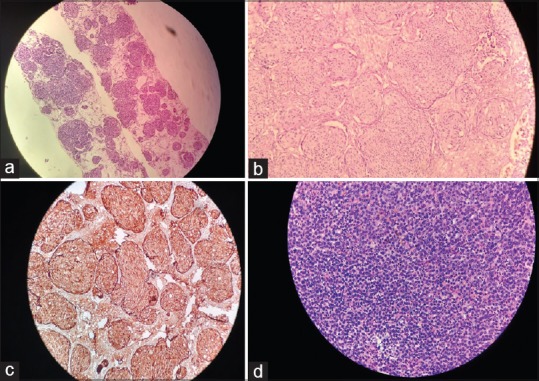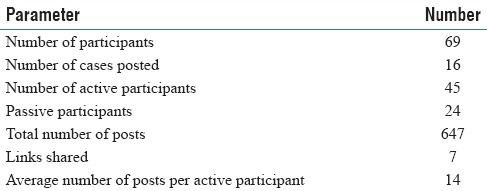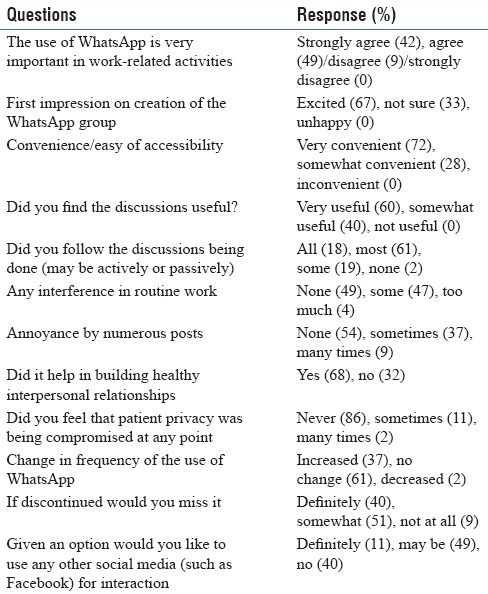Abstract
Introduction:
Postgraduate students spend a sizeable proportion of their time on social media platforms such as WhatsApp and Facebook. This change in our social interaction needs to be accommodated in our teaching methods. To engage them and arouse their curiosity, WhatsApp is an ideal platform. Digital photography by cell phone cameras has made it possible to share cases and discuss them with students round the clock.
Objective:
The primary aim of the study was to develop sharing and discussion of images using WhatsApp. It also aimed at gathering feedback by means of a questionnaire from pathology residents about their views about the use of WhatsApp for teaching purpose.
Materials and Methods:
A WhatsApp group by the name “Pathology on the Go” was created with the authors of this study as group administrators and all junior and senior resident doctors (69) as members. The group was used to discuss interesting cases, quiz questions, and other pathology-related academic issues. At the end of 4 weeks, a questionnaire was distributed among the members, and feedback was sought regarding their experience in the group.
Results:
Over a 4-week period, 16 cases were discussed with 647 posts. A total of 45 participants out of 69 were active participants, and they had an average of 14 posts over the 4-week period. Majority of the participants found the discussions very useful with minimal disruption of the daily routine.
Conclusion:
There is a need to incorporate Web 2.0 tools such as WhatsApp in our teaching methods to capture as much screen time of the students as possible.
Keywords: Pathology, teaching, WhatsApp
Introduction
Technological advancements in mobile phone industry have changed the way we interact with our peers. Increasing use of social media by our present generation of postgraduate students has its own pros and cons. However, if used in the right way, social media might be deployed to supplement medical education. There are certain peculiarities of social media which make it an ideal platform for teaching. It connects a large number of people at the same time and takes time, space, and other logistics out of the equation. The participants have freedom of choosing a time when they want to access the information posted. A single topic of discussion or a single case can be discussed over 1 or 2 days at leisure, which makes the exercise more interesting. Furthermore, there is an element of intrigue since the case unfolds slowly over several hours and makes retention easier. Smartphone camera resolution has improved several times over the last few years. This has made it possible for everyone to take better quality images showing the morphological details of the case with accuracy. Most internet consults come with a disclaimer saying that glass slide viewing is the gold standard for making a diagnosis. This is needed since the accuracy of the consult depends on whether the area photographed is representative or not. In a morphology quiz scenario, the person taking the photograph makes sure that the key finding is included in this study. However, it takes away the skill required to scan the slide and identify the key area. Since social media is only an adjunct and not a replacement of reporting room teaching, it should not be a problem.
Materials And Methods
The study was conducted in the Department of Pathology of University College of Medical Sciences, Delhi. A WhatsApp group by the name “Pathology on the Go” was created with the authors of this study as group administrators and all junior and senior resident doctors (69) as members. The group was used to discuss interesting cases, quiz questions, and other pathology-related academic issues. Participation in discussions and answering the questions posted was voluntary. At the end of 4 weeks, a questionnaire was distributed among the members, and feedback was sought regarding their experience in the group. The participants were asked to freely air their views about the group without mentioning their name in the form.
Relevant statistics about the group such as number of cases discussed, total number of posts, average number of posts, and total number of active participants were also calculated. Any member who had more than two posts during this period was considered an active participant. The group continues to share cases and discuss topics to this day. The participants were also asked to comment whether they would like to use any other social media platform such as Facebook, etc., for similar purpose.
The cases discussed were from histopathology and cytopathology. Cases from routine sign out were not included as that would have compromised patient confidentiality and raised ethical concerns. The cases were chosen from collection of slides of the faculty and were photographed and uploaded for discussion. Few cases were also provided by Dr. Elanthenral Sigamani, Consultant Pathologist, Christian Medical College, Vellore, India. Patient names, exact site of biopsy, and laterality (left or right) were not included in the study. Other patient identifiers such as the hospital where biopsy was done, year of biopsy, and slide accession numbers were also not included in this study. The photomicrographs were uploaded in a sequential manner and not at once.
For example, a case discussion on trucut biopsy of metastatic medullary carcinoma thyroid would begin with a ×10 photomicrograph captioned neck mass [Figure 1a]. The image would act like a teaser for participants who would respond with any broad categorization-carcinoma, paraganglioma, neuroendocrine tumor, adenocarcinoma, and so on. After 10–12 h, the next image (a higher resolution) ×40 would be uploaded [Figure 1b]. This would be followed by a question regarding relevant immunohistochemistry panel. After another 6 h or so, the results of the immunohistochemistry would be divulged [Figure 1c]. The respondents who got the diagnosis right would be applauded. Those who were close (say paraganglioma in this case) would also be given due credit. After this, any one respondent would be assigned the duty to post a detailed account of the case including genetic tests and further workup. To ensure that the discussion is fruitful and no wrong information is shared, all the discussions were overseen by the faculty (Dr. Nadeem Tanveer).
Figure 1.

Cases shared during the study (a-c) metastatic medullary carcinoma thyroid posted as neck mass (H and E, ×10 and ×20, immunohistochemistry for calcitonin, ×20) (d) non-Hodgkin's lymphoma involving pleural fluid-fluid cytology specimen (H and E, ×40)
The main thrust of the group was on generating high-quality discussions on the cases. The idea behind the study group was to involve all the residents with a particular case or a topic and encourage them to post as much information as possible. They were allowed to post screenshots of freely available material on the internet as long as there was no violation of copyright. The cases uploaded were meant to be triggers for discussion. The idea was to discuss everyday cases and not exotic diagnoses.
Results
Over a 4-week period, 16 cases were discussed with 647 posts. Nine cases were from histopathology, and seven cases were from cytopathology [Figure 1]. Seven links regarding online lectures and educational materials were also shared. A total of 45 participants out of 69 were active participants, and they had an average of 14 posts over the 4-week period [Table 1]. Out of 69 participants of this study (excluding the authors of this paper), 57 responded to the questionnaire. The response to the questions is tabulated in Table 2. Almost all the participants favored WhatsApp over other social media platforms citing ease of access and user-friendly interface as the reason.
Table 1.
Statistics of the use of WhatsApp by the group over the study period of 4 weeks

Table 2.
Questions asked to the participants and their responses

The group was successful in creating interest for the specialty among the 1st year postgraduates. Although no formal pre- and post-tests were conducted for this intervention, it is anticipated that if used for a sufficiently long period of time, the academic performance of the students would improve. The key is to find the right balance between online and offline education.
Discussion
Web 2.0 describes the changing trends in the use of World Wide Web technology. It aims to enhance creativity and increase collaboration, hence improving the functionality of the Web. Web-based communities and hosted services, such as social networking sites (i.e., Facebook, WhatsApp), video sharing sites (i.e., YouTube), wikis, and blogs, are all tools of Web 2.0.[1] WhatsApp (WhatsApp, Inc., Mountain View, California, USA) is a proprietary instant messaging client for smartphones. It can be used to send text messages, documents, images, user location, audio messages, and video using usual mobile numbers. It is one of the most popular instant messaging Apps in the world.
Mobile phone internet has changed the way people interact with one another. Taking advantage of the ease of use and accessibility of mobile apps, several internet-based companies have launched medical case sharing apps specifically designed for doctors. Apps such as Curofy are mostly used by specialists to discuss cases and get second opinion by experts. The other apps such as daily round for doctors, prognosis: your diagnosis provide case scenarios for testing the decision-making skills of doctors. While these apps are specifically designed to cater to a large number of doctors and provide avenues for case sharing, the traditional apps such as WhatsApp can be equally effective, especially for smaller group settings. The present generation of postgraduates is already using WhatsApp, Twitter, and Facebook to socialize. Hence, using one of these apps for teaching purpose has the added advantage that it mixes business of teaching with pleasure of daily gossip.[2]
The other advantage is the ease with which links to online YouTube lectures and websites can be shared on the group. The topics discussed can vary from cases from real world to snippets from history, pathology jokes, newspaper clippings, quiz questions, trivia, and so on.
The use of WhatsApp for teaching purpose has its own challenges. A senior facilitator or teacher is a must to keep the discussions broadly limited to academics and not to veer off to departmental gossip or other trivia. It is also time consuming and has the potential to interfere with daily activities of the department and personal life of the members. It is important to realize that internet-based social networking activities are addictive and need to be regulated. Hence, the cases discussed by the group were mostly posted early morning when most residents are on the way to the department. The next sequential microphotograph or immunohistochemistry result was posted around lunchtime. The final diagnosis and discussion was left for evenings. The pace of the discussion was deliberately kept slow to allow everybody to read at their own leisure. Care was taken so that nobody was criticized for making silly mistakes. In fact, an attempt was made to allow everybody to share their thoughts about the case, no matter how outlandish they might seem.
The responses to the questionnaire were very encouraging. A majority of the participants found the discussions very useful with minimal disruption of the daily routine. This was primarily due to judicious use of the app by restricting the time of posting the cases to lunchtime or evening. The cases were discussed at a leisurely pace over 1 or 2 days, so nobody missed out if he/she was busy. The tone of the discussions was informal which helped everybody including the 1st year postgraduates to voice their opinions. The stress was on coming up with as many differentials as possible and not just on getting the answer right.
The online mode of education also opens up possibilities of compiling the cases for future use in the curriculum.
Twitter (Twitter, Inc., San Francisco, California, USA) and Facebook (Facebook, Inc., Menlo Park, California, USA) are other social media tools frequently used by doctors.[3,4,5] Image sharing on social platforms has been a cause of concern for most doctors as it raises ethical issues pertaining to patient privacy. However, most histopathology slides and images cannot reveal patient identity. Few basic rules of thumb need to be followed. Since the images are shared for academic purpose only, it is advisable to not give exact age and round it off to nearest multiple of 5. Always be intentionally vague about the dates. Avoid mentioning the geographic subdivision where the patient may have originated. Avoid mention of laterality wherever possible. Always avoid posting full facial images without written consent from the patient. All these rules were followed in this study while posting the cases for discussion.[6]
Conclusion
Pathologists are taking note of the emergence of social media.[7,8,9] “Web 2.0” tools such as WhatsApp offer the opportunity to supplement traditional instructional methods to capture as much screen time of the students as possible.
Financial support and sponsorship
Nil.
Conflicts of interest
There are no conflicts of interest.
Acknowledgments
The authors acknowledge the support of all the resident doctors of Pathology Department of University College of Medical Sciences, Dilshad Garden, Delhi, for their honest and unbiased feedback and active participation in this study. We also thank Dr. Elanthenral Sigamani, Consultant Pathologist, Christian Medical College, Vellore, for his contribution toward providing interesting cases for this study.
Footnotes
Available FREE in open access from: http://www.jpathinformatics.org/text.asp?2017/8/1/6/201111
References
- 1.Lau AS. Hospital-based nurses’ perceptions of the adoption of Web 2.0 tools for knowledge sharing, learning, social interaction and the production of collective intelligence. J Med Internet Res. 2011;13:e92. doi: 10.2196/jmir.1398. [DOI] [PMC free article] [PubMed] [Google Scholar]
- 2.Hawn C. Take two aspirin and tweet me in the morning: How Twitter, Facebook, and other social media are reshaping health care. Health Aff (Millwood) 2009;28:361–8. doi: 10.1377/hlthaff.28.2.361. [DOI] [PubMed] [Google Scholar]
- 3.Salem J, Borgmann H, Murphy DG. Integrating social media into urologic health care: What can we learn from other disciplines? Curr Urol Rep. 2016;17:13. doi: 10.1007/s11934-015-0570-2. [DOI] [PubMed] [Google Scholar]
- 4.Fuoco M, Leveridge MJ. Early adopters or laggards? Attitudes toward and use of social media among urologists. BJU Int. 2015;115:491–7. doi: 10.1111/bju.12855. [DOI] [PubMed] [Google Scholar]
- 5.Fuller MY, Allen TC. Let's have a tweetup: The case for using Twitter professionally. Arch Pathol Lab Med. 2016;140:956–7. doi: 10.5858/arpa.2016-0172-SA. [DOI] [PubMed] [Google Scholar]
- 6.Crane GM, Gardner JM. Pathology image-sharing on social media: Recommendations for protecting privacy while motivating education. AMA J Ethics. 2016;18:817–25. doi: 10.1001/journalofethics.2016.18.8.stas1-1608. [DOI] [PubMed] [Google Scholar]
- 7.Glassy EF. The rise of the social pathologist: The importance of social media to pathology. Arch Pathol Lab Med. 2010;134:1421–3. doi: 10.5858/2010-0255-ED.1. [DOI] [PubMed] [Google Scholar]
- 8.Nelson B. Should pathology get more social? A growing movement touts the power of social media for the profession. Cancer Cytopathol. 2011;119:291–2. doi: 10.1002/cncy.20193. [DOI] [PubMed] [Google Scholar]
- 9.Allen TC. Social media: Pathologists’ force multiplier. Arch Pathol Lab Med. 2014;138:1000–1. doi: 10.5858/arpa.2014-0071-ED. [DOI] [PubMed] [Google Scholar]


